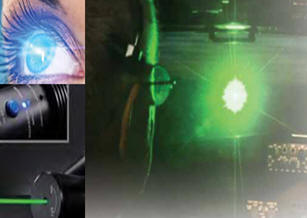|
|||||||||||||||||
|
|
|
|||
|
|
||||
 |
January 20, 2011 - The Federal Aviation Administration
has announced that the number of laser strikes on
airplanes in 2010 nearly doubled from the previous year
to more than 2,800. This is the highest number of
incidents since we first began keeping track in 2005.
Pointing a laser at an airplane is not a harmless prank,
it is a technological assault on the pilot and a serious
safety risk to passengers. Yet laser event reports have
steadily increased since the FAA began collecting
information from pilots. Reports rose from nearly 300 in
2005 to 1,527 in 2009 and 2,836 in 2010.
An
American Airlines 757 is on final approach to |
|||
|
The laser
beam had hit the captain?s left eye with such intensity that he
feels as if he has been ?punched in the eye.? He ducks down,
closes his eyes, and tells the first officer he has been hit by
a laser beam and not to look at the light. The pilot experiences
pain, spasms, and spots in his vision. The flash was so bright
that he believes the aircraft may be the target of a terrorist
attack!
So
distraught by the event that occurred and visibly shaken, he
gives up control of the aircraft to the first officer, who,
fortunately, has not been hit by the laser beam and is able to
land the plane successfully.
The pilot
goes to an eye doctor that afternoon and is diagnosed with
accommodative spasm, sluggish pupil responses, and increased
light sensitivity, which continue on for several days before
finally clearing up. For a while, though, the pilot thinks that
his flying days may be over.
This laser
incident is fictitious but is based on actual events and
personal interviews with pilots that have been exposed to laser
beams while flying here in the |
||||
|
The increase in reports is likely due to a number of factors, including the availability of inexpensive laser devices on the Internet; higher power levels that enable lasers to hit aircraft at higher altitudes; increased pilot reporting of laser strikes; and the introduction of green lasers, which are more easily seen than red lasers Aviators are particularly vulnerable to laser illuminations when conducting low-level flight operations at night. The irresponsible or malicious use of laser devices can threaten the lives of flight crews and passengers. As Federal Aviation Administrator Randy Babbitt wrote in a blog post last month, "Some of these exposures have required pilots to have to temporarily give up control of an aircraft to their co-pilot or abort a landing. There have also been reports of people shining lasers into air traffic control towers." Los Angeles International Airport
recorded the highest number of laser events in the country for an
individual airport in 2010, with 102 reports, and the greater Los
Angeles area tallied nearly twice that number, with 201 reports. Chicago
O?Hare International Airport was a close second, with 98 reports, and
Phoenix Sky Harbor International Airport and Norman Y. Mineta San Jose
International Airport tied for the third highest number of laser events
for the year with 80 each. The top
20 Laser Event Reports By Airport In 2010; |
|
|
| ?AvStop
Online Magazine
Contact
Us
Return To News
|
|

